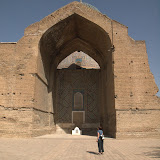
As a child my mum unfortunately felt I was forging a few unhealthy relationships. This resulted in the infamous early 90’s Neal Household Purges. Teenage Mutant Ninja Turtles…banned. Monkey Magic…banned. Simpsons…banned, albeit temporarily. To my delight (and amazement) Indiana Jones and Prince of Persia escaped the wrath of my mum’s stern maternal censorship committee. It is a stretch to say that these phenomena of my youth led to my current resting place being along the Silk Road in Uzbekistan. Yet they did foster some the romantic notions I keep for this corner of the world.
Prince of Persia was an awesome fun 2D computer game set in ancient Persia. As the Prince, your task was to creep through ancient medrasses, leap over spike covered pits and swordfight with the Persian guards in order to save your bride, locked away in a colourful towering minaret. Indiana Jones’ journeys were set in the 20th century. In one of his daring adventures to Cairo he finds himself in a bustling bazaar complete with snake charmers, carpet dealers, worldly spices and sword-wielding Arabs.
Before reaching the Silk Road and the dusty outskirts of what once was Persia, I could be forgiven for expecting a little of what the Prince and Indiana experienced: buzzing marketplaces, winding city streets, minarets and horse-drawn caravans. I was a handful of generations too late. The Soviets (and the subsequent fall of Communism), globalisation and tourism have messed with my Silk Road fantasy.
Like the several cyclists we’ve met in Uzbekistan, we bypassed hot desert cycling in order to take advantage of the excellent train service. No camels or caravans. The highly restored Samarkand glistened in the heat. We followed the neat pedestrian walkways to the stunning local sights. As we followed a path lined with bland new souvenir shops we saw the turquoise domes and medrasses that have aroused visitors for centuries.
We searched in vain for the State Museum of Art, one of the largest in Central Asia. Our map said it should be in the middle of a large park next to the spectacular Registan. Later that evening we ate dinner with other tourists from our guesthouse in a local 19th Century home. Here we learned, from our Uzbek host who once worked at the State Museum, that the government had abruptly dismantled the Museum to build a flat grassy park, as it was not appropriate to have it so close to the grand Registan. Sadly no replacement Museum has been built.
Bukhara has been spared the restoration committee’s scalpel to some degree. Yet, like Samarkand it is an important September destination for the hordes of grey-haired European tour-bus travelers. Armed with their tour guides and point-&-shoot cameras, they swarm over these cities. Local industry has cleverly adapted to the influx of wealthy tourists with a seemingly disproportionate number of ceramic bowel and carpet vendors. It took a few kilometers of strolling out of ‘Old Town’ before we reached the winding pre-Soviet streets with the odd unrestored mosque and countless mud and straw walled houses.
So mum, you can rest assured that I’ve sampled the ubiquitous Uzbek bread, wandered through colourful bazaars and seen towering stunning minarets without the dangers of sword-wielding locals.
 |
| Samarkand |






0 comments:
Post a Comment